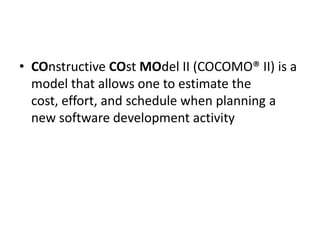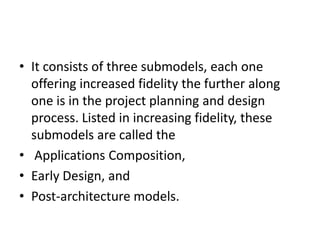New microsoft office power point presentation
- 1. COCOMO II
- 2. • COnstructive COst MOdel II (COCOMO® II) is a model that allows one to estimate the cost, effort, and schedule when planning a new software development activity
- 3. • It consists of three submodels, each one offering increased fidelity the further along one is in the project planning and design process. Listed in increasing fidelity, these submodels are called the • Applications Composition, • Early Design, and • Post-architecture models.
- 4. • COCOMO® II can be used for the following major decision situations • Making investment or other financial decisions involving a software development effort • Setting project budgets and schedules as a basis for planning and control • Deciding on or negotiating tradeoffs among software cost, schedule, functionality, performance or quality factors
- 5. • The original model published in 1981 went by the simple name of COCOMO®. This is an acronym derived from the first two letters of each word in the longer phrase COnstructive COst MOdel. The word constructive refers to the fact that the model helps an estimator better understand the complexities of the software job to be done, and by its openness permits the estimator to know exactly why the model gives the estimate it does





